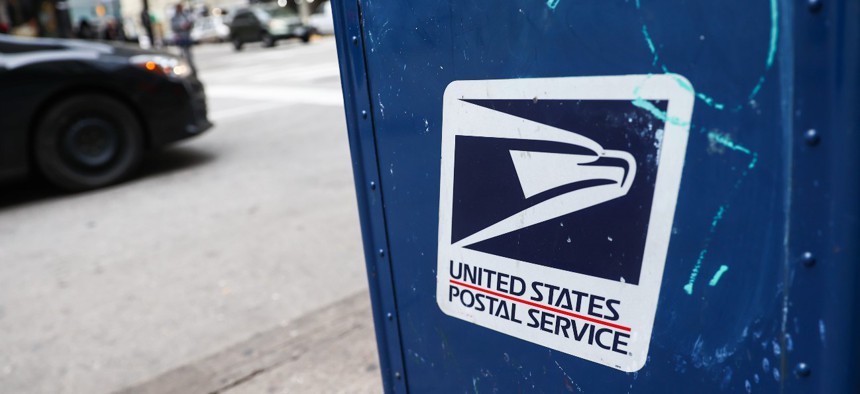
The Postal Service could borrow up to $3 billion in any given year. NurPhoto / Contributor Getty Images
USPS Opens a New Line of Credit With Treasury
The Postal Service has grown its liquidity immensely, but is eligible to borrow up to an additional $5 billion.
The U.S. Postal Service has set terms for additional borrowing from the Treasury Department, opening the door for the mailing agency to take on more debt even as it has greatly expanded its cash reserves.
USPS and the Federal Financing Bank, a government corporation within Treasury that lends money to federal agencies, struck the “note purchase agreement,” or NPA, this week, according to financial documents the Postal Service filed on Thursday. The agency is statutorily entitled to take on $15 billion in debt, but is currently $5 billion below that cap.
Treasury first offered borrowing terms like those agreed to this week in the 1990s after USPS threatened to sell its debt to the private sector, according to Steve Kearney, who served as the mailing agency’s treasurer at the time. While postal management has not announced any specific new loans, the agreement allows it to quickly access the funds should it need them. USPS is only able to borrow up to $3 billion in any given year.
In 2020, the Postal Service stated that its existing agreements with Treasury would expire that spring.
“If the Postal Service is unable to renew or replace the [note purchase agreement] with the [financing bank], it has no assurance that it could obtain alternative debt financing on comparable terms,” USPS said at the time. It added it believed it would be able to “maintain adequate liquidity” to fund its operations “for the foreseeable future” and had no plans to issue additional debt.
As of its end of fiscal 2022 filing, the Postal Service noted it still did not have an agreement in place with Treasury.
“While the Postal Service may issue debt obligations within its statutory borrowing authority, it has no assurance that it would be able to raise additional cash through new debt financing with the [Federal Financing Bank] or from other lenders, or that such financing would be provided on terms comparable to those applicable to its prior debt issuances,” the agency wrote.
During the COVID-19 pandemic, Congress provided the Postal Service with a $10 billion cash infusion. President Biden then signed the Postal Service Reform Act into law last year, which erased $107 billion in obligations from the agency’s books. Congress subsequently provided another $3 billion for USPS to purchase more electric vehicles and charging stations. It ended 2022 with $23.1 billion in cash on hand, up from less than $3 billion 10 years prior. The Postal Service paid $1 billion back to the Treasury last year, bringing its outstanding balance down to $10 billion.
Interest rates in the current market are unusually high, which could also prove a costly environment for USPS’ borrowing. The average interest rate for all the Postal Service’s outstanding debt was 2.757% at the end of fiscal 2022 and while it did not disclose the terms of its latest agreement, it would likely face a higher percentage this time around.
Still, Kearney, now the executive director at the Alliance of Nonprofit Mailers, said it was wise for USPS to make this agreement now.
“It’s a prudent thing to have in place at all times so it’s there when you need it,” he said.
Postal management hinted at why it may need to tap into its borrowing authority in the near future. The agency is in the midst of implementing Postmaster General Louis DeJoy’s Delivering for America plan, which is aimed at bringing the Postal Service’s finances out of its current hole by 2030. That will include making $40 billion in capital investments to improve its network and facilities. Any “shortfalls or delays in implementation of the plan,” USPS said, “will place additional pressure on our liquidity and financial results.”
“As a result of these concerns, we may not have sufficient liquidity to meet all of our existing legal obligations when due while also repaying our maturing debt and making the critical infrastructure investments that have been deferred in recent years,” the agency said.
As part of its new agreement with Treasury, USPS is required to maintain an escrow account with nine months of projected interest payments. It will next face a principal payment of $1 billion in 2024.
The Postal Service on Thursday announced a net loss of $1 billion in the first quarter of fiscal 2023—the Oct. 1 through Dec. 31 period is typically its most profitable of the year—though it grew its operating revenue by more than $200 million. Excluding matters management views as outside of its control, such as retiree health benefit expenses, USPS turned a profit of $187 million. That was down from a $880 million profit during the same period in fiscal 2022, as mail volume continued its longstanding decline and package volume dropped off from its pandemic high point. Postal management has already conceded it will not hit its goal to break even by 2023.
“Elevated inflation continues to have a significant impact on our results," USPS Chief Financial Officer Joe Corbett said. “We continue to manage costs within our control by focusing on maximizing labor productivity and optimizing our network.”







